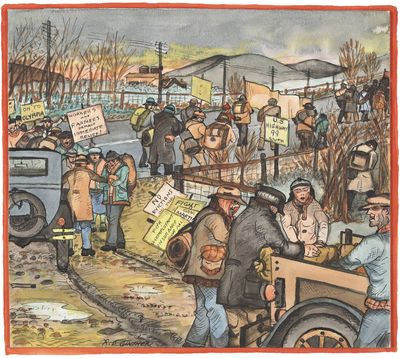Library ties DIY events to exhibit on Great Depression

A library exhibit about the Great Depression aims to draw connections between the people who made do then and the people making do now.
That’s why, along with exhibits of Depression-era artifacts and oral histories of people who lived through it, the Spokane County Library District is offering free classes on thrift-store treasure hunting, preserving produce, and repurposing old furniture or décor. The latter sessions, led by Kelly Lynch-Chevalier, aka “the Retro Vixen,” are called “Is That New? Make Cheap Stuff Good.”
The traveling exhibit, “Hope in Hard Times,” was curated by the Washington State Historical Society and co-sponsored by Humanities Washington. It aims to explore Americans’ adversities and triumphs during the Depression, comparing the struggles of the 1930s with those faced today. But librarians have worked to give it a local angle, digging up supplementary artifacts and personal stories from Spokane-area residents.
And they’re hoping to tap into a resurgent interest in do-it-yourself projects at home by offering how-to classes at library branches throughout the county, along with talks on the music, films and stories of the 1930s.
“We can look at their resilience and the ingenuity they used to survive the hard times,” librarian Ellen Peters said. “What lessons can we take away that will help us in current times?”
The libraries – already a resource for those seeking new jobs and new skills during hard economic times – have in recent years seen a surge in interest in DIY projects such as canning and gardening, said Gwendolyn Haley, library services manager for the Spokane County Library District.
Lynch-Chevalier said she grew up poor in the Seattle area in the 1980s. Her father, a shipyard worker, was often on strike. Her family accessed food and clothing banks for help.
“We learned how to make our own things and do with what we had, kind of like the Great Depression,” she said. “A lot of people are going back to that now, because times are tight. … People are finding the simplicity of what we can create can be good, and you can save yourself money.”
The physical exhibit at the North Spokane Library combines art, text and artifacts – with dust and dirt left on – to evoke the time and spark questions, librarian Vanessa Strange said. The artifacts came from area residents’ stashes and antique stores.
Some came with stories attached.
A scale in a display of kitchen objects was used to weigh a library staffer’s grandmother when she was born. Enlarged receipts in one display case came from the Five Mile Dairy, which operated where the Five Mile Shopping Center sits now.
Photographs on display include iconic Depression-era images (such as Dorothea Lange’s “Migrant Mother”) but also paintings by Ronald Debs Ginther, who lived in a Hooverville on the West Side and documented what he saw: men climbing aboard boxcars or sharing food around a campfire, farmers bringing in supplies to people staging a “hunger march.”
Kids who visited the library recently built a mini Hooverville – a cardboard-box version of the shanty towns constructed by homeless people throughout the U.S. – in the children’s books section.
Other visitors have used chalk to jot memories or family stories on a board near the entrance. “My great-grandmother was evicted by the bank,” begins one entry.
Librarians also collected oral histories from area residents who lived through the Depression. Most residents who were interviewed touched on a similar theme, Peters said: “They see it as a good thing that they persevered, that they pulled together, that they found humanity. Therein lies the hope.”